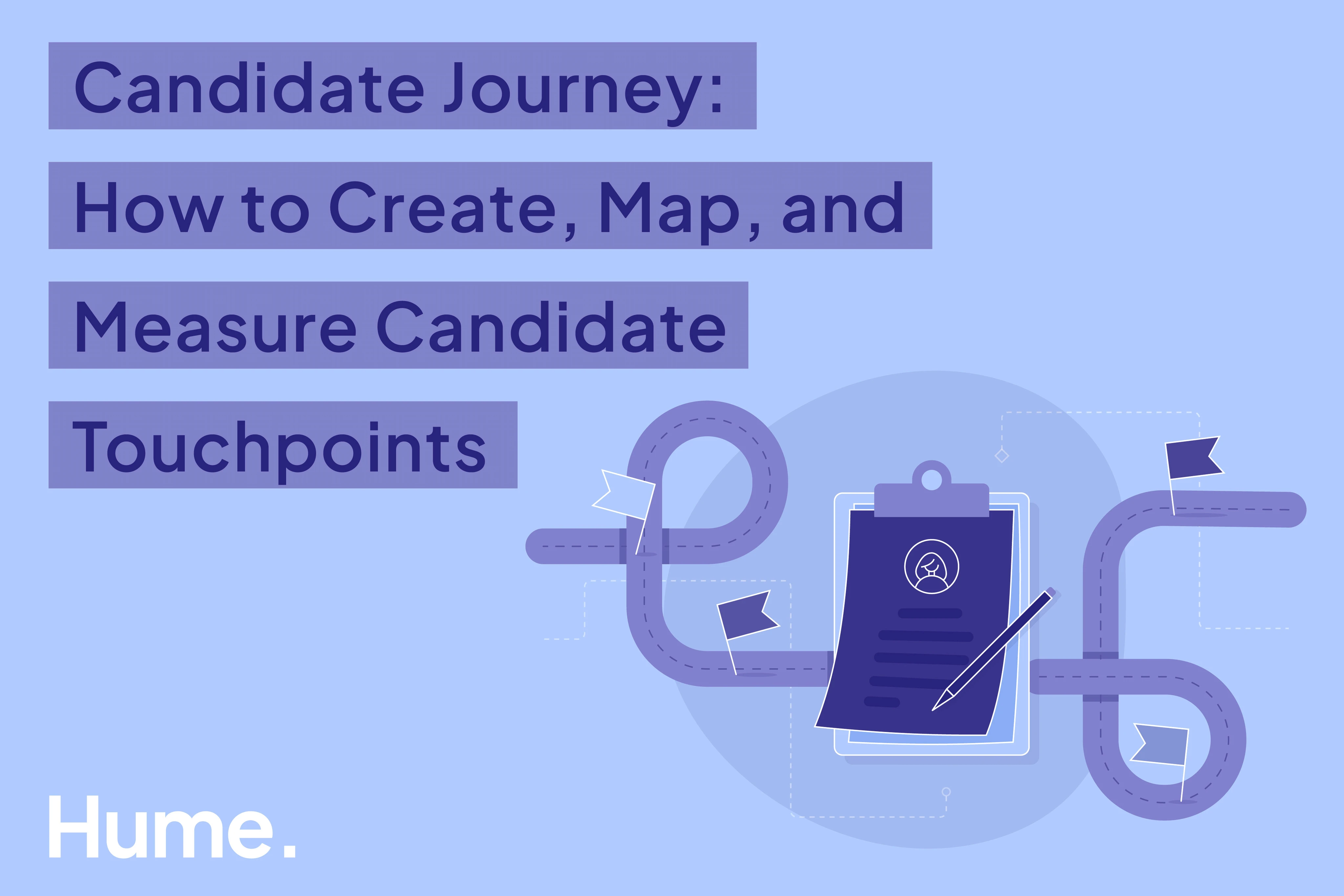Candidate Journey: How to Create, Map, and Measure Candidate Touchpoints
Job seekers interact with companies across multiple touchpoints — both in-person and virtually. How to better map out and understand the candidate journey.
5.0

Add an AI assistant to your interviews
Start with 5 interviews for free
Already have an account?
Log in
You are how you treat people. For companies, that includes rejected job applicants.
Sometimes, employers forget how large their hiring pool actually is. This makes them overlook the countless opportunities candidates have to interact with their company. To ensure a positive experience for all, you need to understand where all these job seekers are coming from.
So let's talk about the candidate journey: what it is, how you can map it, and tips for how to improve the candidate experience so that all applicants feel seen and heard.
What is the candidate journey?
A candidate journey is the path a prospective employee takes toward finding and getting a job.
It's often compared to the customer journey toward purchasing a good or service. If you need a new pair of pants, you may think about whether they should be jeans, slacks, joggers, etc…, then learn about all the different brands, then read product reviews, then ask friends for advice, and finally decide if (and where) you want to buy them.
Job seekers have a similar journey. Take Zoe, our hypothetical candidate who's spent two years at her current role and is considering a change. She'll mention to friends that she's on the job hunt, consult LinkedIn and other social media feeds, research roles on message boards and company websites, interview for different jobs, and ultimately decide on one of them based on her candidate experience.
The journey starts before the candidate applies to any jobs. Then it doesn't end until after they've accepted a role and finished onboarding.
This path is often depicted as a funnel (similar to the sales funnel) because the hiring pool dwindles as people advance through stages of the journey — going from leads to candidates to hires.
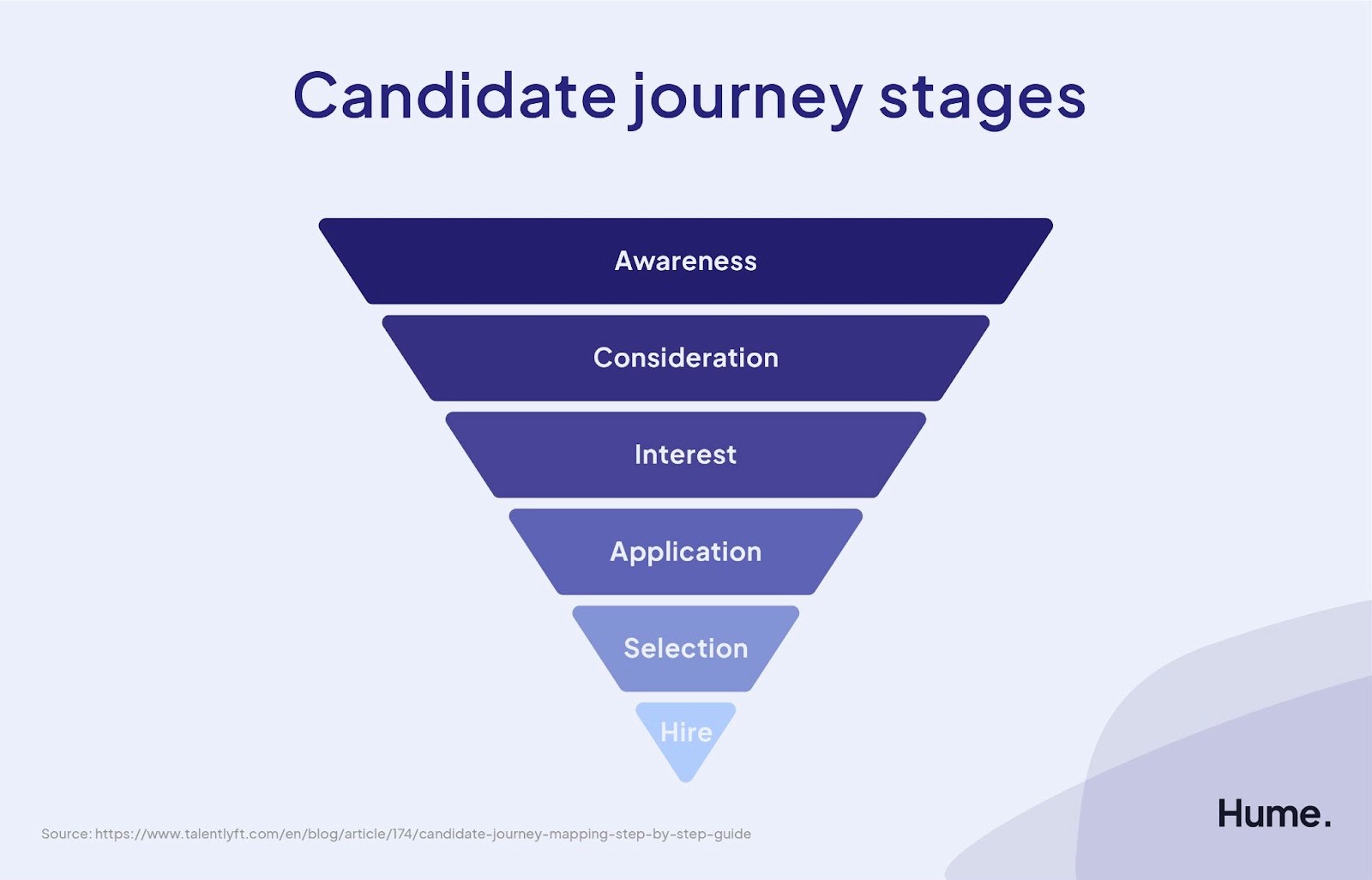
The 6 Stages of the candidate journey
Below is each stage, along with a glimpse into our candidate Zoe's thought process.
Awareness. What jobs are out there? What is this company? What do they do?
Consideration. What makes me a good fit here? What value can I bring to the company?
Interest. What makes this company stand out? Is this somewhere I can see myself growing?
Application. Has anyone looked at my online job application? Did I get an interview? How can I nail it?
Selection. Are they interested in hiring me? Does it still seem like a place I'd want to work?
Hire. Thanks for the offer — I'll take it!
Why does the candidate journey matter?
Hiring is a two-way street. Your best candidates are likely weighing a slew of other job openings, and they're judging whether they fit within your company with the same rigor your company uses to judge their candidacy.
That's why their hiring experience is so important. In fact, 67% of job seekers reported a negative candidate experience in the last year, and 58% declined a job offer because of it.
And a lousy candidate experience is almost always due to a long, tricky, and inconvenient journey. Anytime a prospective employee wades through a disorganized interview process, discovers the role's real responsibilities don't match the job description, or feels iffy about company culture — it likely means their journey wasn't planned out properly.
This spells dangerous consequences for your company's brand. In one study, 37% of candidates said they've left a negative review about an employer after having a bad hiring experience. But on the flip side, 61% of candidates said they left a positive review if the experience was smooth.
Be it online or offline, you have to game out every opportunity candidates have to connect with your company. See next:
What you need to know about touchpoints
The funnel-like shape of the candidate journey is a helpful visualization. But in reality, the actual path is nonlinear. Job seekers pave their own ways toward offers, at their own speed. And they probably have multiple in-person and virtual interactions with your company — whether it's your employer brand or the people who work there — before completing the journey.
These interactions are called touchpoints.
For instance, our candidate, Zoe, may:
See a friend advertising your job on social media.
Visit your website and consult your careers page.
Check how employees review your company on job boards.
Grab coffee with a friend, who's a recruiter, to discuss the role.
Browse her college's alumni talent network.
Talk to a hiring manager at a job fair.
Fill out an application on your online job portal.
Interview over Zoom.
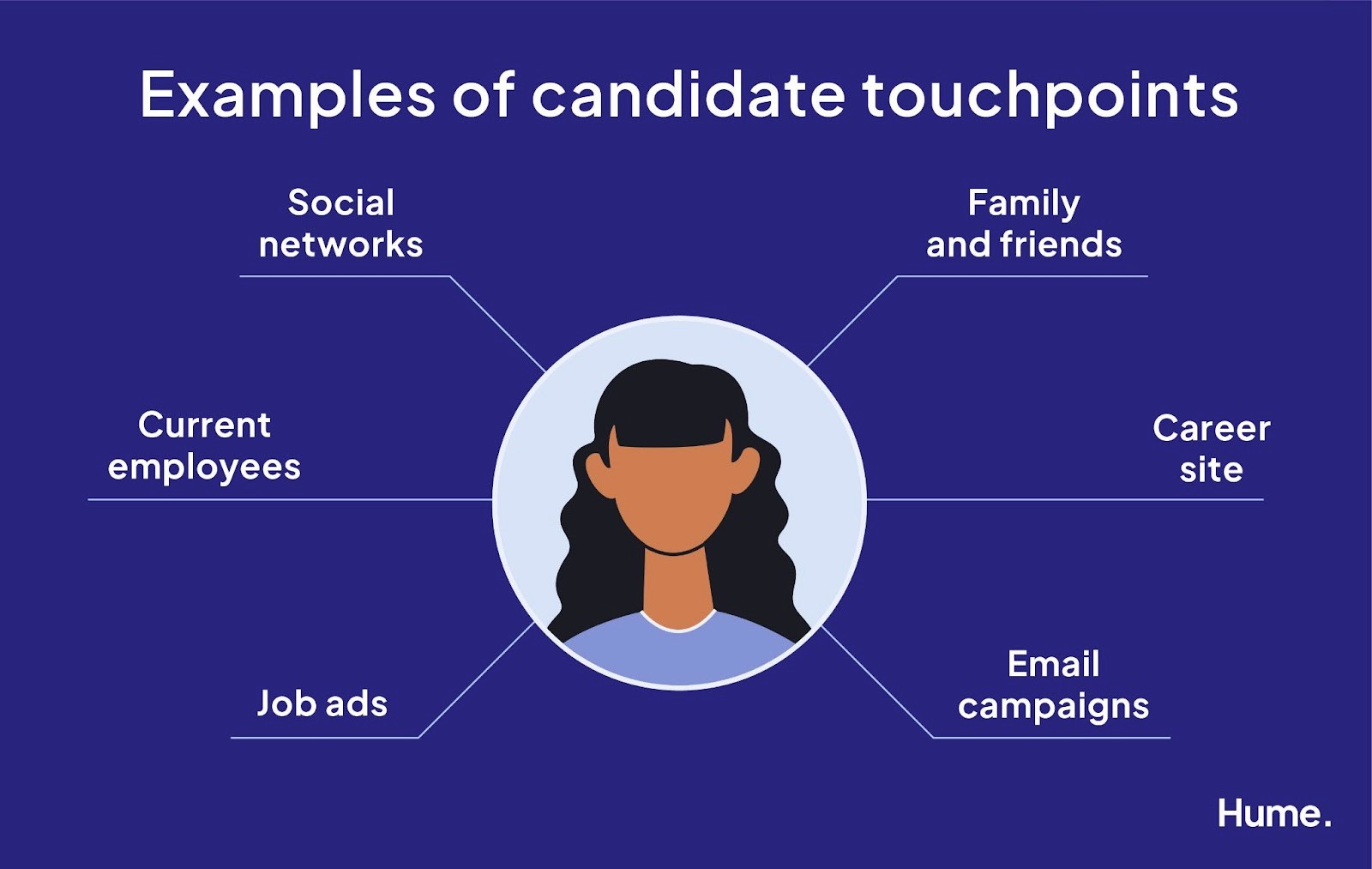
Knowing these touchpoints lets you track how candidates are interacting with your company at different stages of their journey.
If you represent this visually, you have your map!
Why is it important to map the candidate journey?
Mapping lets you envision the journey from the candidate's perspective. This way, you can anticipate what the candidate wants at every stage and deliver a more targeted experience, all while improving your recruitment marketing strategy.
For instance, if you find candidates get a lot of mileage out of social media during the "awareness" phase, but find in-person interactions are more fruitful when they're strongly considering the role, then you can allocate resources accordingly by only involving recruiters after a candidate shows strong interest.
According to 80% of job seekers, this kind of breezy experience makes candidates likelier to accept a job offer, which, in turn makes it easier to hire top talent — all while lowering costs and reducing time to hire.
The 4 steps to mapping out your candidate journey
Seeing as how 91% of the workforce looks for new job prospects every year, your hiring pool is bigger than you realize. Here's how to map out the candidate journey so that you can access as many of those recruits as possible:
1. Sketch your candidate persona
When you think of your ideal candidate, what comes to mind?
Think of the skills you'd like that person to have. What kind of work environment do they prefer? What are their career goals?
These traits will help you dream up your candidate persona. It's rooted in real-people qualities, but it doesn't have to be a real person.
What matters is that you're getting specific about skills and behavioral traits. Because those people will have a certain kind of candidate journey, different from other candidate personas.
For example, if you're looking for entry-level sales representatives, you may want to focus on getting the word out in early career job fairs. If you want a more seasoned sales team lead, you probably want to take advantage of different touchpoints, like getting a senior executive to send a personal email.
2. Identify candidate journey touchpoints
Think about what your candidate persona wants. Is it more money? Less oversight? A flexible schedule?
What about their needs — more psychological safety? A greater sense of career purpose?
Answers to these questions help you predict a job seeker's behavior when interacting with different companies. And, as we discussed, those interactions make up the touchpoints. List all of them, trying to identify which touchpoints your candidate persona interacts with at each stage of the journey.
Keep in mind that you're likely to have both passive candidates, who may be happily employed but occasionally browse their prospects, and more active job seekers, who want that next job ASAP. Passive candidates may employ different touchpoints than active ones.
3. Put together a list of channels
Touchpoints are how a candidate interacts with your company (e.g., a career site). Channels are the specific tools that candidates use to make those interactions happen (e.g. Indeed or ZipRecruiter).
This to say the same touchpoint can have multiple channels — either online or offline — within it. For instance, maybe our hypothetical candidate Zoe uses Ivan, her old college friend who's a recruiter, as a touchpoint to learn more about the company.
She could scroll through Ivan's LinkedIn profile, chat with him about the available role over coffee, look at his bio on the company website, E-mail him questions, and have Ivan put in a word-of-mouth referral to a supervisor. These are five different channels for the same touchpoint.
It's worth noting that candidates can use tons of different channels to complain about a lackluster candidate experience. For instance, if you never updated someone about their application status, they could leave a bad Glassdoor review, fire off a frustrated Tweet, complain to their friends about it in person at brunch, etc…
4. Draw your candidate journey map
Here's the fun part.
With all the information you've accumulated in the previous three steps, you can make a visual representation of one job seeker's candidate journey.
There's no prescriptive template for this. But the more candidate data you have, the merrier. This should include demographic information, along with the touchpoints and channels the candidate used at each of the six stages of the journey.
Here's an example of a candidate journey map for Zoe:
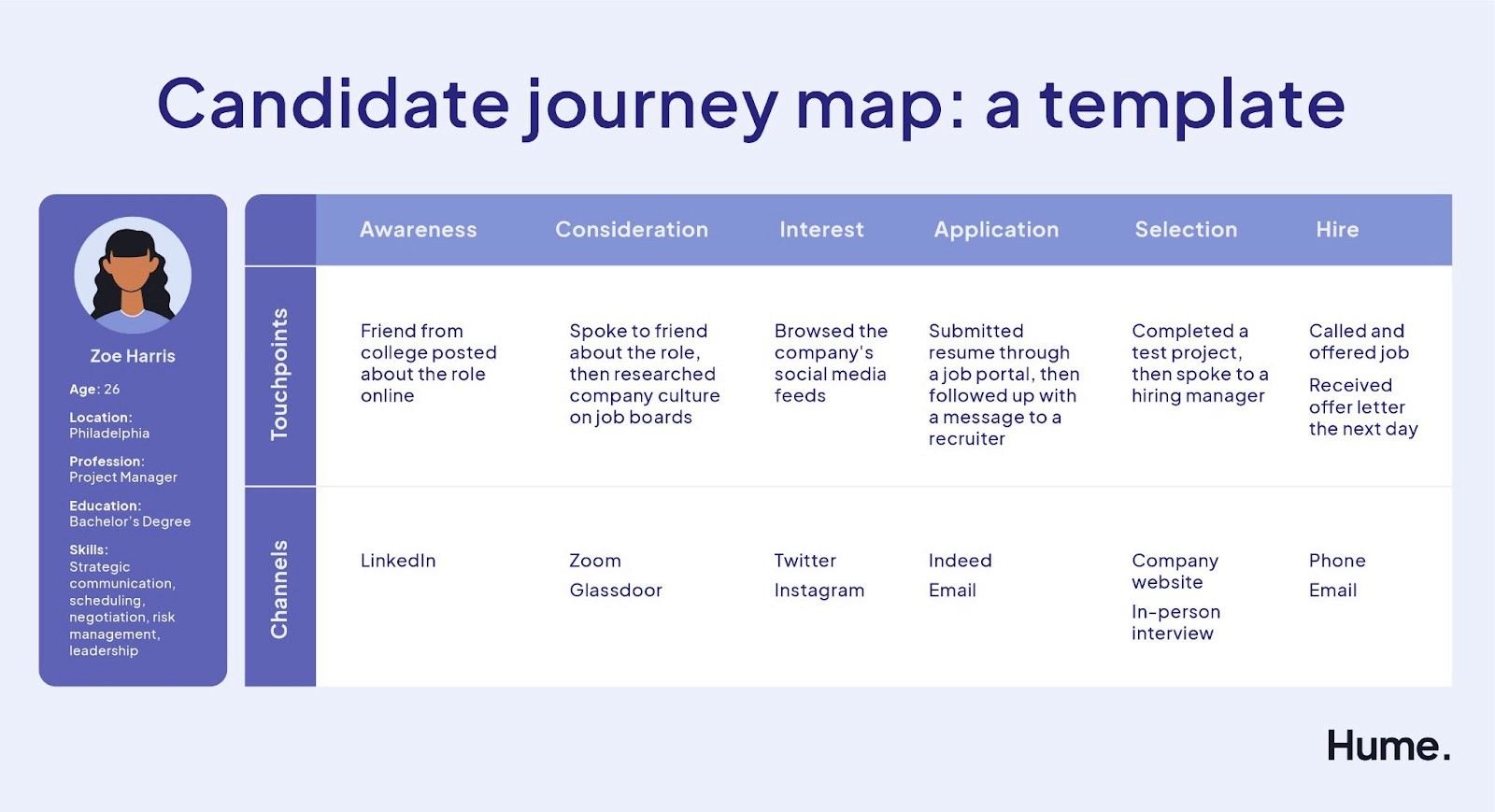
Tips to ensure a smooth candidate journey:
Now that you know how to map the candidate journey, here are some tips on how to make it more efficient, all while maximizing the candidate experience.
Place candidates front and center
If the hiring process is the solar system, your candidate is the sun. Companies need to focus on candidates at every stage of the journey — paying proper attention to any wants, needs, and pain points.
This means being both communicative and transparent at every phase of the application process.
You may think this is wasted time, seeing as how you're picking one candidate out of a bountiful hiring pool. But candidates you turn down may be a great fit for the role a couple years down the line. They may also have friends or colleagues who'd be great hires in other departments.
By keeping your journey centered around the candidate, you're bolstering your company brand while ensuring no one leaves the experience with a sour taste in their mouth.
Think about employer branding
Your company's reputation matters. Three quarters of candidates think about it before applying for a job. And according to one study, almost 70% of all job seekers refuse to work anywhere with a bad rap.
This is something worth considering across every touchpoint, throughout every stage of the journey. Whether you're sending emails, posting to job boards, sending recruiters to expos, or writing blog posts on your website, every interaction with a candidate has the potential to either boost or harm your reputation.
Put yourself in the candidate's shoes
Earlier, we talked about how sketching your candidate persona makes for a breezier hiring experience. But it also helps for anyone involved in talent acquisition to swap perspectives. If you were a candidate, what does the ideal job look like?
It's likely one where the candidate feels respected, understood, and fulfilled. Maybe it's one with a four-day workweek. Maybe it's one that encourages colleagues to spend time with each other outside of work settings. Regardless of what you come up with, thinking like the candidate helps you anticipate their needs and design your recruiting process around them.
Show what it's like to work with you
The best candidates need an honest impression of what day-to-day work with your company actually looks like. Zoe may be excited about researching, applying, and interviewing for a role, but none of those steps speak to the job itself. You don't want a candidate to be unpleasantly surprised with the role after it's too late.
This is where creative supplements to a job interview come into play. Think about giving finalist candidates a test assessment that mimics real work they'd be doing. You can also consider having them shadow an employee for a day, or getting them to interview with every colleague they'd be working with. This helps with retention — the more people new hires speak with before their start date, the likelier they are to stick around.
Measuring your candidate experience
You've cobbled together your touchpoints. You've pinpointed which channels facilitate those touchpoints. You've even visualized it all onto a map for each individual candidate journey. But how exactly do you use this to evaluate candidate experience?
You need, in a word, data. For one, you can solicit feedback from candidates at each stage of the hiring process. Consider using hiring software to automatically send out surveys to accepted and rejected candidates. Asking short questions like, "how satisfied are you with your job seeking experience here?"
If you score these responses with a rubric, you can measure them against one another and ensure they're improving over time. And if you're doing this across touchpoints, you can develop a sense of how different recruiting tactics work for different interactions.
But the true goldmine for data lies in your interviews. You just need a way to harness it…
Unlocking your interview data with Hume
Hume is an AI-powered interview companion that records and transcribes conversations with candidates. Instead of scribbling pain staking notes, you can focus directly on the interviewee, ensuring a much more pleasurable candidate experience.
But that's just the tip of the iceberg. Hume also lets you annotate interviews. You can tag sections of the transcript where candidates discuss the touchpoints they interacted with, and then use those tags to help map out their unique journey. This way, every job seeker leaves your hiring process feeling valued. Why? Because the platform keeps conversations fair, focused, and personalized.
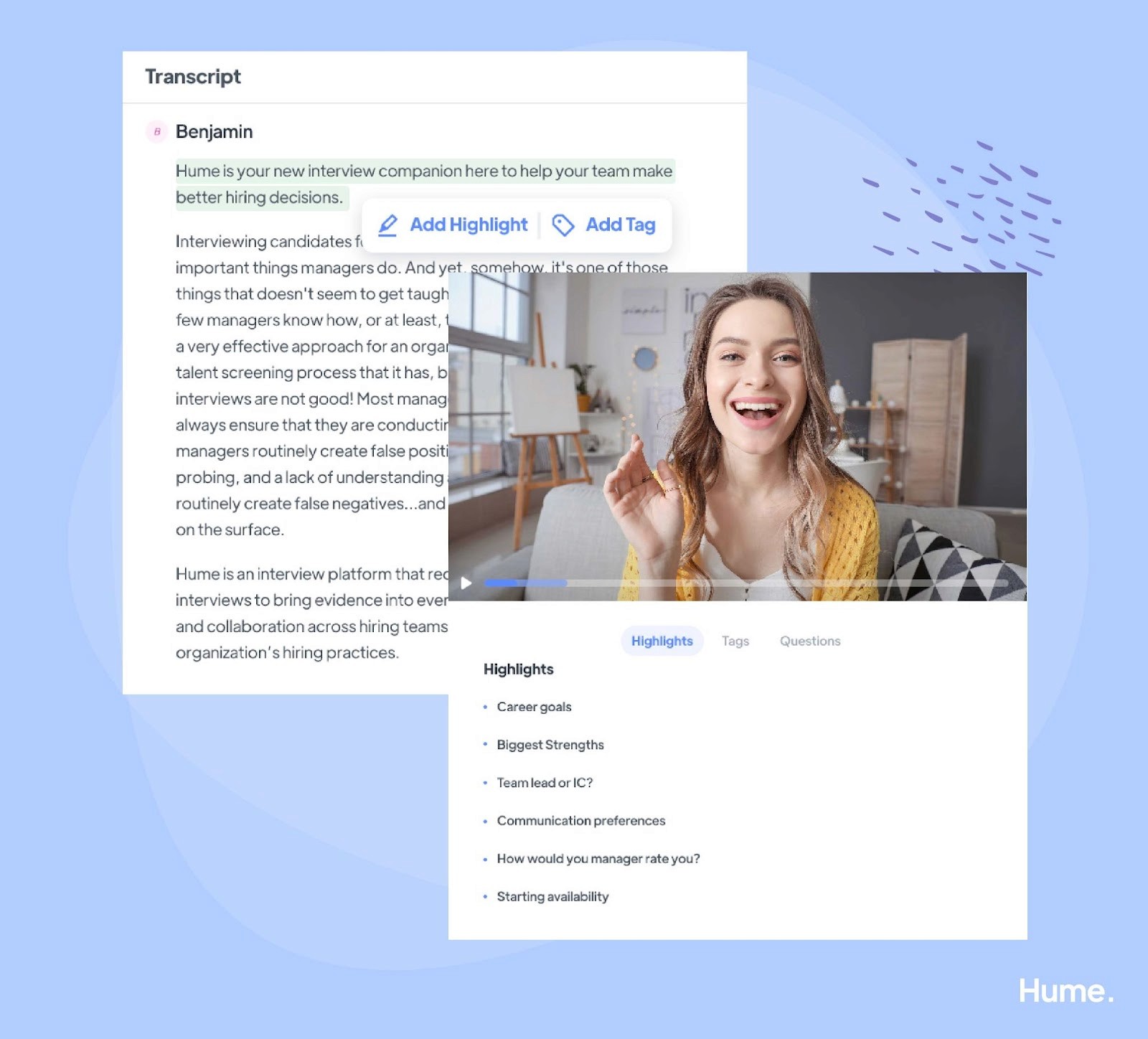
Hume takes all the guesswork out of hiring by placing your interviews into a searchable repository. This way, recruiters, hiring managers, and all other interviewers can easily prepare for their conversations and quickly discover which common traits your top talent shares.
Hiring experiences can get torpedoed by slipshod, unstructured interviews — which are cesspools for dangerous types of bias. But with Hume, you can ensure every interview follows a consistent line of questioning and delivers the fairest possible experience. Seeing as how most interviewers lack formal training, you can even build a coaching library of best practices that all hirers can turn to for insight.
A smooth candidate journey makes for a delightful candidate experience. This does wonders for your company's reputation and promises a worthy ROI. See how Hume can help you create, map, and measure a journey any candidate would love to travel by visiting our homepage to sign up for the waitlist or following us on LinkedIn.
Imagine transforming every interview into a strategic advantage. Dive deep into every conversation, free from the distraction of note-taking. This isn't just wishful thinking – with Aspect, it's how you'll redefine your hiring process.
Beatriz F
People Success Specialist
Absolutely game-changing for busy recruiters!
The summary, the Q&A feature and the ATS integration have boosted my productivity and lowered the context-switching stress, the analytics provided allowed for me and my team to have full visibility over our stats, and Aspect's team couldn't be more helpful, friendly and accessible!
More Content On Talent Acquisition

